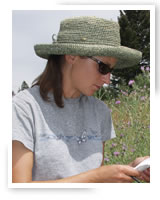Tanya Skurski
RESEARCH OVERVIEW:

I am interested in the composition and dynamics of natural plant communities and the
processes structuring them. My current focus is the community-level impacts of two
non-native plant species, Centaurea maculosa (spotted knapweed) andBromus tectorum (downy brome). Using species removal experiments, I am quantifying changes in species
richness, diversity, composition and biomass over time and across multiple sites.
Impact estimates will be used to parameterize models to predict where these non-native
plants are likely to have the greatest impact and how management may be optimized.
In addition, I am quantifying the effectiveness and non-target plant impacts of common
herbicide treatments for C. maculosa and B. tectorum. Comparisons of these two types of impacts, the impacts of the non-native species,
and the impacts of herbicide treatments, can inform management decisions within a
trade-off analysis framework.
Other questions I am addressing through my research include: Are there thresholds
for impacts of non-native plants (minimum abundance below which impacts are negligible)?
Can non-native plants significantly alter successional processes in grassland ecosystems?
What are the criteria of a ‘properly functioning’ terrestrial ecosystem such as a
grassland? Under what circumstances are non-native plants likely to alter systems
in a biologically significant way?
Former PhD Student, graduated 2012
Dissertation title: Quantifying non-native plant impacts: Centaurea stoebe L. (spotted knapweed) and Bromus tectorum L. (downy brome) in sagebrush-grasslands of the Greater Yellowstone Ecosystem
Current appointment as of July 2012: Postdoctoral Researcher working with Beth Leger at the University of Nevada, Reno Department of Natural Resources and Environmental Sciencehttp://www.ag.unr.edu/leger/Leger/Home.html and Jeanne Chambers at the Rocky Mountain Research Station Reno Great Basin Ecology Laboratory http://www.fs.fed.us/rm/reno
Current research: My current research is focused on the effects of both climate and disturbance on the population biology of the dominant non-native forbs in Great Basin plant communities. Non-native annual grasses, especially cheatgrass (Bromus tectorum), have been the primary focus of both research and management efforts towards understanding the causes and effects of weed invasions in the region and in developing restoration approaches. As a result, we know relatively little about the population dynamics of the weedy forbs in these communities, which can be very abundant, or the successional dynamics of these mixed grass and forb weed communities. I am also investigating competitive dynamics among invasive annuals and the role of these forbs in the successional dynamics of these communities.
Publications while with our WIPEM group:
Skurski, T.C., B.D. Maxwell, and L.J. Rew. Ecological tradeoffs in non-native plant management.Biological Conservation (Accepted).
Skurski, T.C., B.D. Maxwell, and L.J. Rew. Mechanisms underlying non-native plant impacts: a review
of recent experimental research. (In revision).
Skurski, T.C., B.D. Maxwell, and L.J. Rew. Quantifying non-native plant impacts for natural areas
management: a review of experimental research. (In revision).
Skurski TS, Maxwell, BD, Rew, LJ (2011) Impacts of exotic plants in natural systems: methods
and findings of experimental research. “Ecological Effects of Invasive Plants” Symposium, Western Society of Weed Science. Spokane, WA, March 11, 2011. [Invited]
Skurski T, Rew LJ, and Maxwell BD (2010) Assessing invasiveness of non-indigenous plant populations:
a post-establishment, empirically-based methodology. Society for Range Management and Weed Science Society of America, “Working landscapes
providing for the future”, February 7-11 2010, Denver, Colorado. p80.
Skurski T, Rew LJ, Maxwell BD and Lehnhoff E (2010) Quantifying invasiveness as part of a weed
management prioritization framework. Montana Weed Control Association Annual Meeting.
January 13th, Missoula, MT.
Skurski T, Maxwell, BD, and Rew LJ (2009) Quantifying changes in density and spatial extent
of multiple Centaurea maculosa populations. Poster Presentation. The Ecological Society of America Conference August 2-7, 2009 Albuquerque, New Mexico.
Skurski T, Maxwell, BD, and Rew LJ (2009) Quantifying plant community impacts of Centaurea biebersteinii and Bromus tectorum. Western Society of Weed Science, March 10-12, 2009, Albuquerque, New Mexico. p. 19
Skurski T, Maxwell, BD, and Rew LJ (2009) Assessing plant community and environmental covariates
of Bromus tectorum presence. Western Society of Weed Science, March 10-12, 2009, Albuquerque, New Mexico. p. 6
Click on an image to view as a slideshow.


